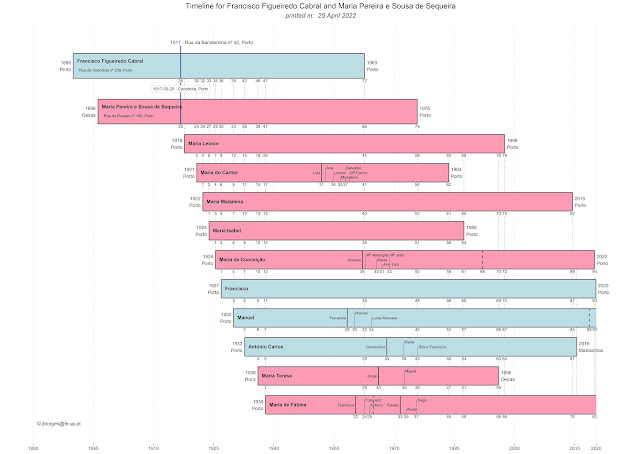The nuclear family timeline emerged from the curiosity of understanding my father's age when some events happened. I knew my father was born in Lisbon and that at a young age, his family moved to the north of Portugal, first to Felgueiras and later on to Leça da Palmeira. The plot below was created to clarify that information.
The plot represents the timeline of a nuclear family. On top, in thicker rectangles, we have my grandfather (in blue) and my grandmother (in pink). Their year and local of birth and death are indicated next to the rectangle. Inside the rectangles, we show their names and known residences before their marriage.
The blue vertical line indicates their marriage and the label between the spouses indicates the date and local. The label on top of the blue line indicates the year of marriage and their residence after marrying.
Slightly thinner rectangles indicate their children, also colored by gender. Their first child was a daughter, Maria Emília, born in 1924. My grandfather was 30 years old and my grandmother 24, a fact indicated by the dashed lines. My grandfather died in 1956 at 62 years old, and my father, the younger child, was 26.
The blue dashed lines indicate changes of residence. They moved to Felgueiras in 1943, and my father was 13. In 1947 they moved to Leça da Palmeira, and my father was 17.
If a child married and had offspring, that is indicated inside the corresponding rectangle. My father, Adriano José, was 32 when he married Maria and had four children. He was 37 when I was born.
It is also interesting to note that my grandfather did not know any grandchild while my grandmother died after all being born.
The following plot represents the timeline for the nuclear family of my maternal grandparents. My mother is the fifth child, Maria da Conceição. She was born in 1926; her mother was 29, and her father 35. She was 36 when she married my father, Adriano José, and 41 when I was born. The dashed line indicates my father's death; she was 66.
The two open-ended boxes indicate children who are still alive when printing the plot. The younger child, Maria de Fátima, had two marriages, first with Francisco, from whom she became a widow, and then with Fausto.
We discuss the Contextual Family Tree on the next page.






Comments
Post a Comment